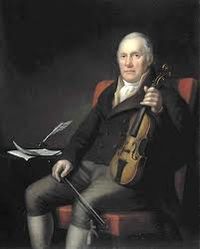Hello! Ask me (almost) anything about traditional music.
Annotation:Miss Admiral Gordon’s Reel
X: 1 T:Miss Admiral Gordon's Strathspey M:4/4 L:1/8 C:William Marshall (c.1775) R:Strathspey F:http://www.betsyhooper.com/sitebuildercontent/sitebuilderfiles/Scot4 B: Marshall's Scottish Melodies B: Marshall's Strathspey Reels (1781) K:A E \ | "A"A/A/A A>A A>E A<f | "A7"e<cB>A "D" F2 F>E \ | "A"A/A/A A>A "F#m"A>E A<f | "Bm"e>f a<c "E7"e3 || f \ | "A"e>f a<c "A7"e<cB>A | "D"B>c d/c/B/A/ "E7"F2 F>E \ | "A"A/A/A A>A "F#m"A>E A<f | "D"e<c "E7"B>c "A"A2 A |] E \ | "A"C>EA>E "D"F>E"A"A>B | "A7"c>e d/c/B/A/ "D"F2 FE \ | "A"C>EA>E "D"F>E"A"A>B | "F#m"c>d e/f/g/a/ "E7" e3 || g \ | "A"a>gf>e "A7"f>ed>c | "D"Bc d/c/B/A/ "E7"F2 F>E \ | "A"A/A/A A>A "F#m"A>E A<f | "D"e<c "E7"B>c "A"A2 A |]
MISS ADMIRAL GORDON'S REEL/STRATHSPEY. AKA and see "Glasgow Flourish," "Of all the airts the wind can blaw." Scottish, Slow Strathspey ("Slow when not danced"). A Major (most versions): D Major (O’Farrell, Rook). Standard tuning (fiddle). AB (most versions): AABB (O’Farrell): ABCD (McGlashan). One of the first composed and most famous tunes (c. 1775) by Scots fiddler William Marshall (1748 1833) in honor of Margaret Gordon, daughter and only surviving child of Admiral William Gordon (d. 1769), Carmelite House, Banff; four other children died before adulthood. Margaret survived to marry Mr. Forbes-Seton of Aberdeen, and their daughter married Lord James Hay. Moyra Cowie (1999) points out that Banff was a social hub for the well-to-do of North East Scotland in the 18th century, many of whom retained town-houses there and who spent the season socializing. Cowie believes Marshall would have met many through his position as the 4th Duke of Gordon’s Steward of the Household. The Admiral’s Carmelite house, which he built, survives today and has been converted into a small hotel.

“Miss Admiral Gordon” was first published in Marshall's Strathspey Reels (1781, p. 3). As was not uncommon, it was republished afterwards by Joshua Campbell, although unattributed and renamed "Glasgow Flourish" after that city's motto (Alburger, 1983). Niel Gow wrote a tune called "Major Graham of Inchbrakie," which has a similar motif, and there have been accusations by some (e.g. John Glen) of plaigerism; it appears derivative in any case (as is the Gows' "Sir John Whitefoord's Strathspey," both published in their 1784 First Collection). Its popularity is due in part to the fact that Robert Burns wrote one of his best songs to it which begins: "Of all the airts the wind can blaw." Burns' manuscript notes for the Scots Musical Museum contain the following: "I have been told by somebody who had it from Marshall himself, that he took the idea of his three most celebrated pieces, 'Marquis of Huntly's Strathspey (1) (The),' 'His Farewell,' and 'Miss Admiral Gordon's Reel' from the old air, 'German Lairdie (The)'" (Emmerson, 1971). William Stenhouse maintains that Marshall fashioned the tune from the old melody of "Lowlands of Holland (2)" (by adding a second part), but John Glen (1891 & 1895) disputes this, saying that Stenhouse was in error and that "Lowlands of Holland (2)," especially as published by James Oswald in the Caledonian Pocket Companion, bears no resemblance. Nor does Glen credit Johnson (Scots Musical Museum) or Urbani (2nd Volume, 1794) who also published "The Lowlands of Holland" with originating "Miss Admiral" for they were both published after Marshall published his tune (i.e. in his 1781 Collection of Reels). However, it has been noted (by James C. Dick, The Songs of Robert Burns, 1903) that "The rudiments of this fine melody can be seen in the Skene MS., c. 1630, under the title "Alace! I lie my alon I'm lik to die auld." Burns wrote his lyric in honor of his bride to be, Jean Armour, while he was at Ellisland awaiting her arrival from Mauchline in Ayrshire, where he had first met her.
O a' th'I dearly lo'e the west
For there the bonnie lassie lives,
The lass that I lo'e best.
Tho' wild woods grow an' rivers tow,
Wi' mony a hill between,
Baith day and nicht, my fancy's flicht,
Is ever wi' my Jean.
The melody has been used for other songs, including a Canadian folksong, “The Scarborough Settlers’ Lament” and a Scottish song “The Scottish Settlers’ Lament” (see Stan Rogers’ album “For the Family” and the Tannahill Weavers’ album “Land of Light,”, respectively).


